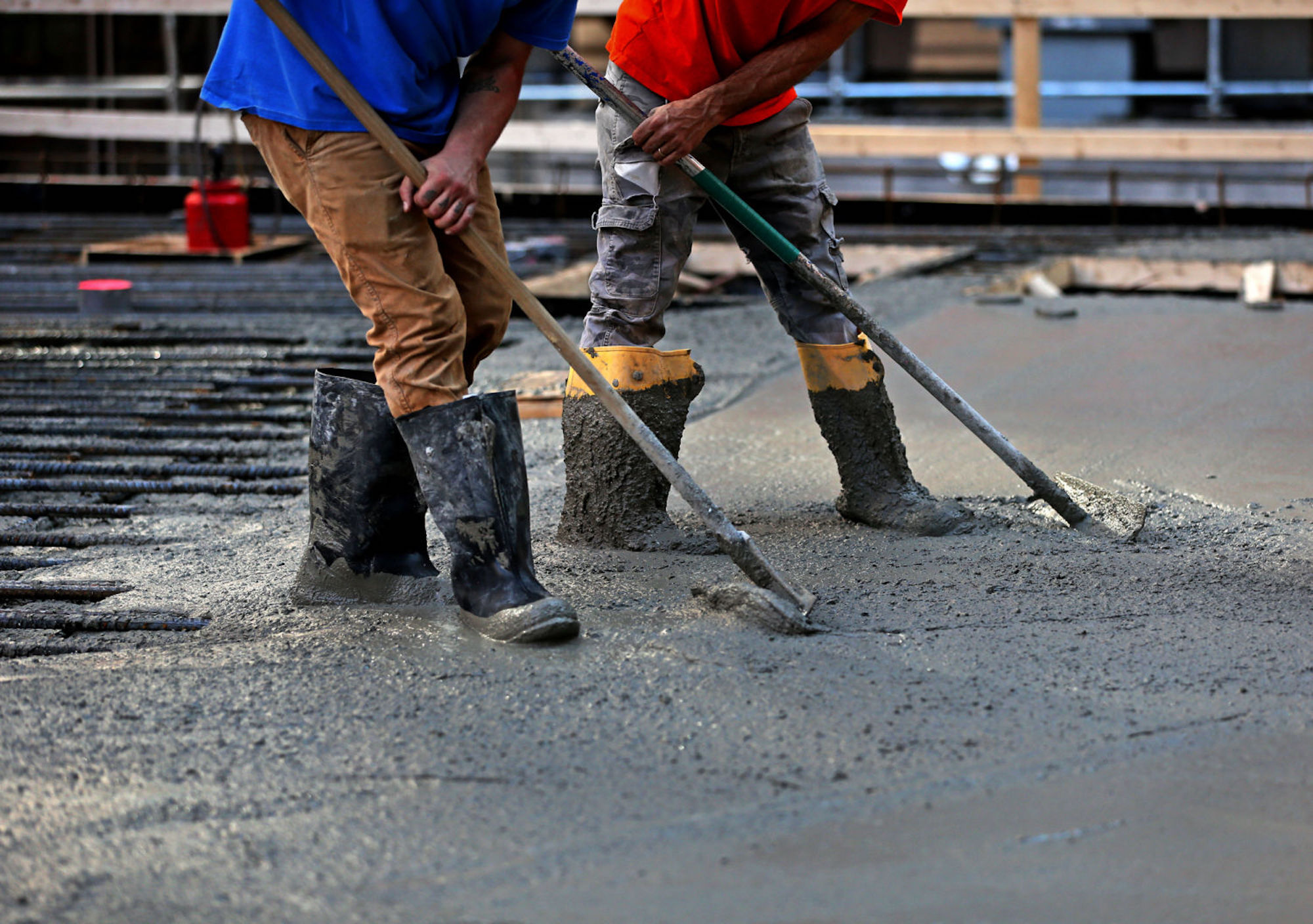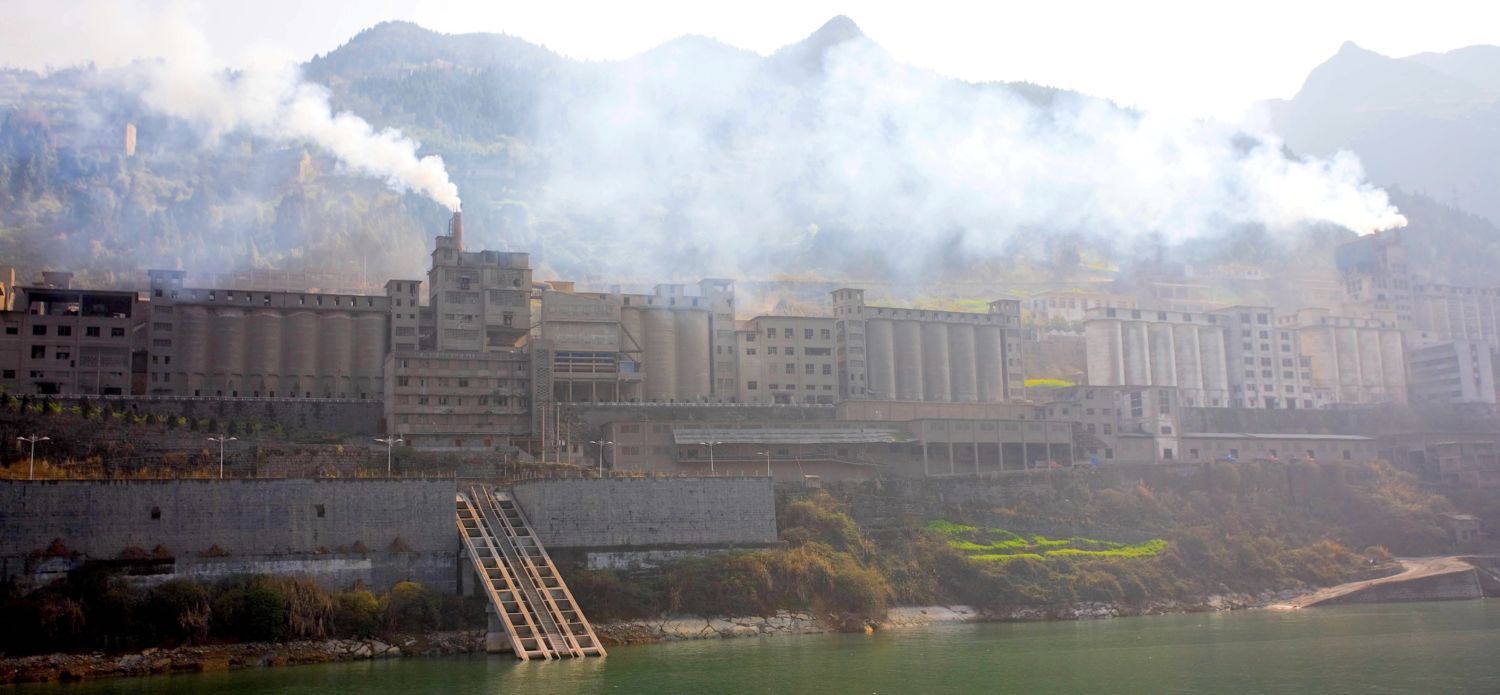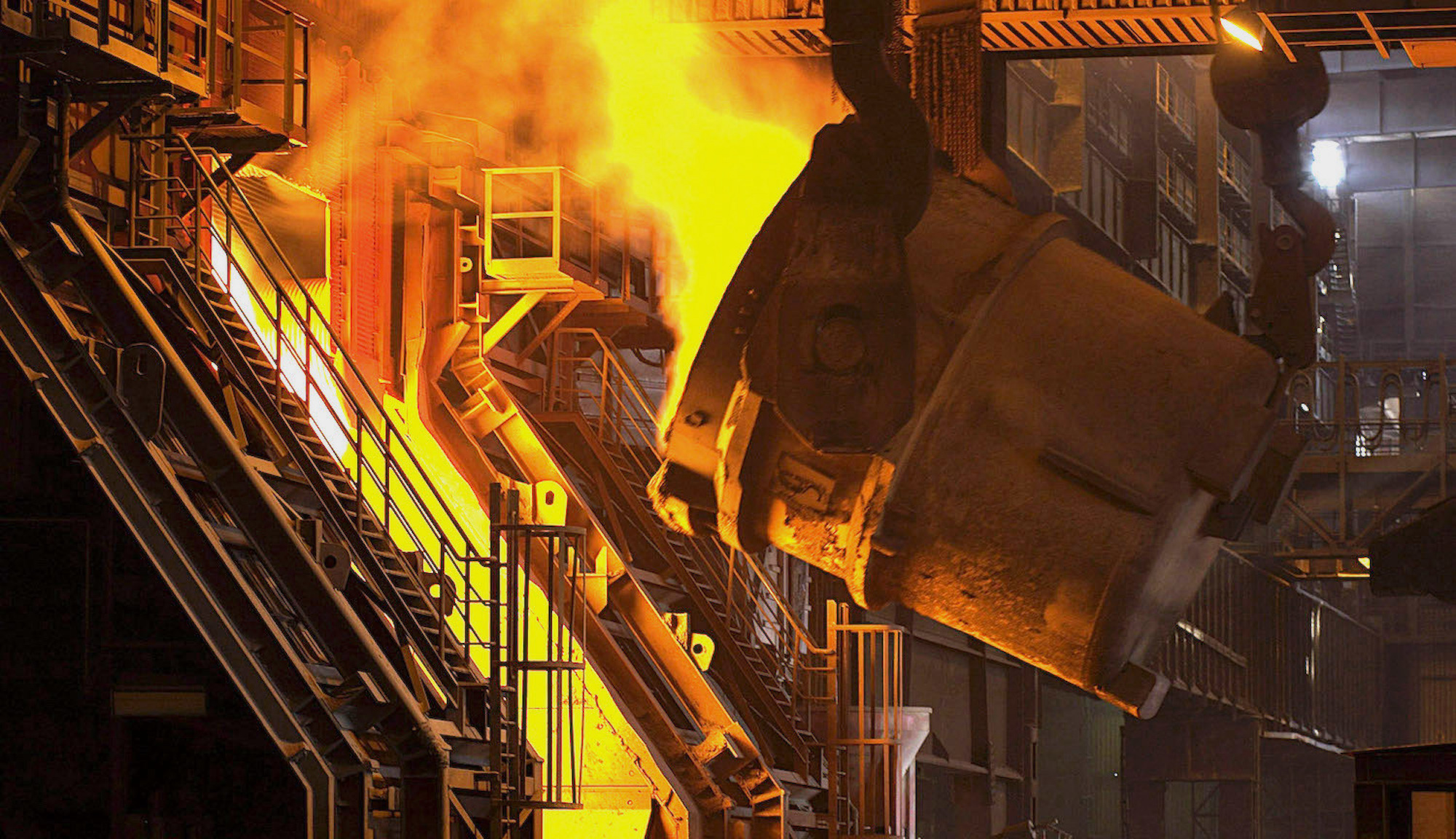This story was originally published by Yale Environment 360 and is reproduced here as part of the Climate Desk collaboration.
We know how to decarbonize energy production with renewable fuels and land transportation with electric vehicles. Blueprints for greening shipping and aircraft are being drawn up. But what about the big industrial processes? They look set to become decarbonization holdouts — the last and hardest CO2 emissions that we must eliminate if we are to achieve net-zero emissions by mid-century. In particular, how are we to green the three biggest globally-vital heavy industries: steel, cement, and ammonia, which together emit around a fifth of anthropogenic CO2?
Our modern urban environments are largely constructed from concrete — which is made from cement — and steel. Most of our food is grown through the application of fertilizer made from ammonia. These most ubiquitous industrial materials are produced at huge expense of energy and carbon dioxide emissions.
Their staid industries have prospered for over a century using largely unchanged manufacturing processes. But the urgent need to produce green ammonia, steel, and cement is starting to shake them up. Research is providing new options for fundamental changes to chemical processes. And in recent weeks, leading players have announced major initiatives in each of these three crunch industries.
Two emerging technologies are advertising themselves as the “solutions” to decarbonizing problem industries. One is carbon capture and storage (CCS), which aims to capture stack CO2 emissions and bury them in geological structures such as old oilfields or salt mines. The other is “green hydrogen,” made by splitting water using renewable energy. Some see green hydrogen as the dream fuel of the future, powering everything from planes and power stations to homes and heavy industry.
U.S. Energy Secretary Jennifer Granholm said in June that “clean hydrogen is a game changer,” because it “will help decarbonize high-polluting heavy-duty and industrial sectors.”
But both technologies face technical criticism and accusations of hype. CCS is accused of being designed more to prolong the future of fossil-fuel industries than to decarbonize the world’s economy. And even green hydrogen, which is essentially a conveyor of renewable energy, seems pointless for applications where the renewable energy can be used directly — by plugging in electric vehicles, for instance.
Yet each may have a role in certain industries, industry analysts say. “Primary steel and ammonia production are sensible entry points for green hydrogen,” Falko Ueckerdt of the Potsdam Institute for Climate Impact Research told Yale Environment 360. Hydrogen is very efficient at fueling high-temperature industrial processes, for instance, so green hydrogen could sometimes be the real deal for heavy industries that currently require fossil fuels as part of the process (steel), already use hydrogen (fertilizer), or need the high temperatures hydrogen is good at producing (cement).
Let’s take each of these industries. What do they need to decarbonize?
Steel manufacture is currently responsible for 11 percent of anthropogenic CO2 emissions. Most production starts by burning coal with iron ore in a blast furnace. The coal generates heat but is part of the chemical process in the furnace. It strips oxygen from the ore to make pure iron, known as pig iron, which is turned into steel in an electric arc furnace. But the waste product — from combining carbon in the coal with the oxygen in the ore — is large quantities of carbon dioxide. The entire process emits an average 2.2 tons of CO2 for every ton of steel.
So what can be done to reduce these emissions?

More efficient use and recycling of the product should always be the first avenue pursued. Recycling avoids the blast-furnace stage, with its heavy emissions. The scrap is fed into an electric arc furnace, which typically produces only 0.3 tons of CO2 for every ton of steel. Emissions could be reduced further by switching away from fossil fuels to produce the electricity. But the potential gains from recycling are limited, according to analysts. Around 85 percent of discarded steel is already collected for recycling. But steel’s long in-service life means that this recycled scrap still makes up only around a third of total steel production, according to the International Energy Agency (IEA).
Widespread adoption of CCS could potentially further reduce emissions. But bigger gains may arise from abandoning the blast furnace altogether. The main alternative approach for making pig iron is to run a huge direct electric current through the ore. This process, known as electrolysis, is how bauxite ore is turned into aluminum. The energy demands are huge, but without the need for coal as part of the process itself, that energy could come from a low-carbon source, such as green hydrogen. So green hydrogen is seen as vital to green steel.
This hydrogen route is currently being tried in Europe, under state subsidies, by both ArcelorMittal, the world’s second-largest steel manufacturer, and in a project announced earlier this month in the Netherlands by India-owned Tata Steel.
It could catch on. An attractive approach would be to make the hydrogen on the same site as the steel. It represents a “huge opportunity” for Australia, which has both big iron ore mines and plentiful solar energy, according to Jessica Allen and Tony Honeyands of the University of Newcastle, New South Wales, “It would boost our exports, help offset inevitable job losses in the fossil fuel industry, and go a long way to tackling climate change,” they argued in a recent blog post.
The manufacture of ammonia fertilizer has been one of the fastest-growing industries worldwide over the past half-century. It was the bedrock of the agricultural green revolution of the late 20th century and today nourishes the crops that feed 40 percent of the world’s population. Fertilizer is by far the main use of the 176 million tons of ammonia produced annually.
Ammonia is made using the Haber-Bosch process, invented by German chemist Fritz Haber in 1908. It won him a Nobel Prize a decade later. The process is in two stages. First it manufactures hydrogen, usually from natural gas; then it synthesizes the hydrogen with atmospheric nitrogen. To do this requires breaking the tight bonds that hold together molecules of nitrogen in the air, and that requires high pressures and temperatures of around 500 degrees C.
Both hydrogen production and ammonia synthesis are energy-intensive. The entire process, carried out in giant industrial plants, emits roughly two tons of CO2 for every ton of ammonia and is responsible for around 2 percent of anthropogenic CO2 emissions.
Fertilizers are one of the most wastefully used of all high-carbon products. Less than half of what is poured onto fields gets anywhere near roots — a proportion that has been falling in recent years, according to Xin Zhang, an environmental scientist at the University of Maryland. This not only causes unnecessary CO2 emissions, but also floods the natural environment with nitrogen — creating algal blooms in rivers and dead zones in the oceans, and damaging biodiversity almost everywhere. So using fertilizer more efficiently should be a high priority.
But beyond that, both stages of the fertilizer production process need to be decarbonized. The first stage, making hydrogen, should be the most achievable. In April this year, the world’s largest ammonia manufacturer, CF Industries, announced plans to “green” part of the hydrogen production at its largest production complex, in Donaldsonville, Louisiana. It is installing German-made equipment to make hydrogen by splitting water, using renewable energy.
Decarbonizing the second stage, ammonia synthesis, requires a major improvement on — or replacement of — the existing process. Justin Hargreaves at the University of Glasgow, Scotland, says catalysts are key to the process. They are necessary to break the strong bond of the nitrogen molecule so the element can combine with hydrogen.

The Haber-Bosch process uses an iron catalyst. But ever since its invention, the game has been on to find something that works efficiently at lower temperatures and pressures. “Tackling low-temperature ammonia synthesis is one of those holy grails of chemistry,” says Levi Thompson, a chemical engineer at the University of Michigan. But the chemical necessary to achieve this has so far eluded researchers.
“Nature does it,” Hargreaves told e360. “Nitrogen fixation by bacteria in plant roots happens under ambient conditions, with no high temperatures or pressures. But rates of production are too slow to be practical for large-scale production.” The hope is that the right catalyst could change that. “It is a big prize, if we could do it,” Hargreaves said.
Plenty of industrialists are in the game. A Japanese company, JGC, has a trial plant at Fukushima combining solar energy to make green hydrogen using a new ruthenium catalyst that it has developed for ammonia synthesis. The company claims to have cut the pressure needed for manufacture by three-quarters. Another Japanese team, headed by Hideo Hosono at the Tokyo Institute of Technology, is championing a lanthanum-cobalt catalyst. He claims it cuts the temperature required to 400 degrees C.
Some foresee future processes that ditch the conventional Haber-Bosch process entirely. In June, Doug MacFarlane and colleagues at Monash University in Australia, announced success in developing an electrochemical process for breaking the nitrogen bonds that could produce ammonia at room temperatures. They say the key was the addition of phosphonium salt, which dramatically speeded up reactions.
The third carbon dinosaur — and potentially the most difficult to reform — is Portland cement, so named because it resembles a building stone quarried on Portland, a peninsula in southern England. It was invented in 1824 by an English stonemason called Joseph Aspdin. The manufacturing process mixes chalk or limestone (calcium carbonate) with clay and cooks the mix in a kiln at 1450 degrees C, triggering chemical changes that create a hard solid, called clinker, which is combined with gypsum to make cement. The cement is then mixed with aggregates and water to create concrete.
The high temperatures in the kiln require a lot of energy, typically gained from burning fossil fuels that emit CO2. In addition, when the calcium carbonate is converted in the kiln, the main by-product is yet more carbon dioxide. When the kiln fuel is coal, kilns emit around one ton of CO2 for every ton of cement manufactured.
Every year more than 4 billion tons of Portland cement are produced worldwide, more than half a ton for every inhabitant on the planet. It makes our world of dams, roads, bridges, tower blocks, sea walls, and parking lots. And it is responsible for around 8 percent of anthropogenic CO2 emissions.
How to change this? While most of the world’s steel gets recycled, very little of its concrete does. Buildings could be designed to be taken apart again and their components used again. But few are. When wrecking-ball teams arrive, little of the rubble they create finds any future use, other than landfill or as aggregate. That needs to change, says Brian Norton of the Dublin Institute of Technology. “Buildings … should be designed to be easily disassembled at the end of their use.” Or we could use other construction materials, such as sustainably sourced timber.
But what of the cement production process itself?
If the coal in the kiln were replaced by green hydrogen, that could cut overall CO2 emissions — but only by about a third. So something needs to be done to get rid of the CO2 generated by the production process.
One means is CCS to capture the CO2 emissions. The IEA, in a recent report on pathways to net-zero, saw CCS contributing up to 55 percent of potential emissions reductions in the industry by 2050. Another way is to find industrial uses for the CO2. Earlier this month, French cement producer Vicat announced plans to divert 40 percent of the CO2 from its kiln at Montalieu-Vercieu near Lyon to manufacture methanol to fuel new containers ships being built by the world’s largest shipping line, Maersk.

But there are also decarbonizing options for changing the raw materials of the cement production process. The IEA says that potentially as much as half the clinker in cement could be replaced with other materials, ranging from raw limestone to fly ash from power stations, discarded tires, and domestic refuse.
More radically, German researchers in a study published last month suggested that at least half of the limestone in the kiln could be replaced by alumina-rich clay, known as Balterra clay, that often overlies geological reserves of bauxite, the raw material of aluminum. Herbert Pollmann of the Martin-Luther-University in Germany says this calcium sulphoaluminate cement both avoids the CO2 emissions from firing calcium carbonate and cuts firing temperatures from 1450 degrees C to 1250 degrees C. “Our method not only releases less CO2 during the chemical conversion, but also when heating the rotary kilns,” Pollmann says, potentially reducing overall emissions by two-thirds.
Another potential solution, invented 20 years ago by Australian industrial chemist John Harrison, replaces limestone with a similar rock, magnesium carbonate, often known as magnesite, found in the mineral magnetite and in mixtures with calcium carbonate such as rocks known as dolomite, which roast at much lower temperatures, around 650 degrees C, so requiring only half the energy. But Harrison says magnesium carbonate’s biggest benefit is the ability of the resulting concrete to absorb atmospheric CO2 while in use.
This “carbonation” carries on as long as the material is exposed to the air, potentially recapturing all the CO2 released when it was made. Thus, he says, structures made of his “eco-cement” could act rather like a tree — constantly taking up CO2.
Regular cement also carbonates, but Harrison says his version continues much longer. This contention was challenged five years ago when a study suggested carbonation of conventional cement was greater than generally realized. Unnoticed by climate scientists, the study found, “existing cement stocks worldwide absorb approximately one billion tons of atmospheric CO2 each year.”
Still, Michael Taylor of the London-based Mineral Products Association believes Harrison’s invention has potential value. Its main problem, he suggests, may be the notorious conservatism of the cement industry. Initial costs for new formulations are high, and providing the durability of the finished product could take decades. “Innovators … experience this conservatism as a considerable barrier, and may believe it has been raised simply to frustrate their objectives,” Taylor says.
It is a familiar problem. But, as with steel and ammonia, political pressure for greener processes could change that.



